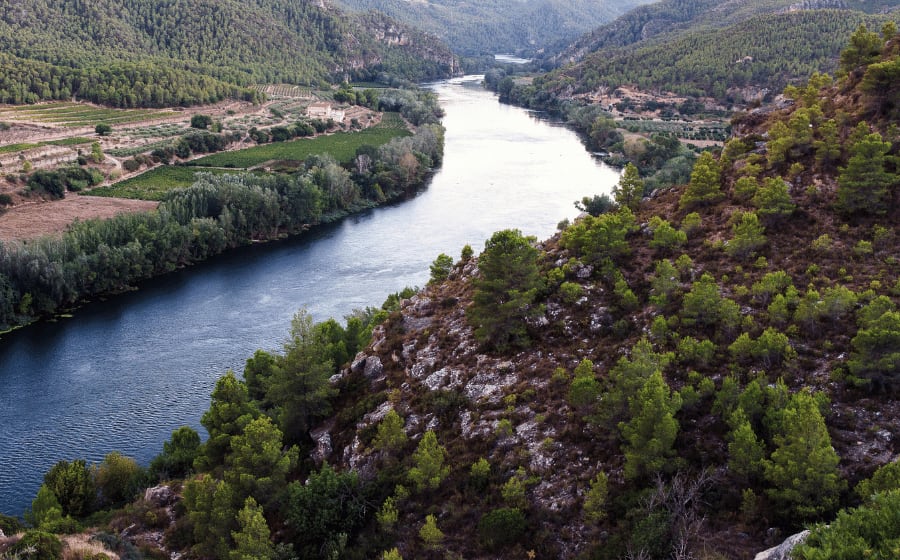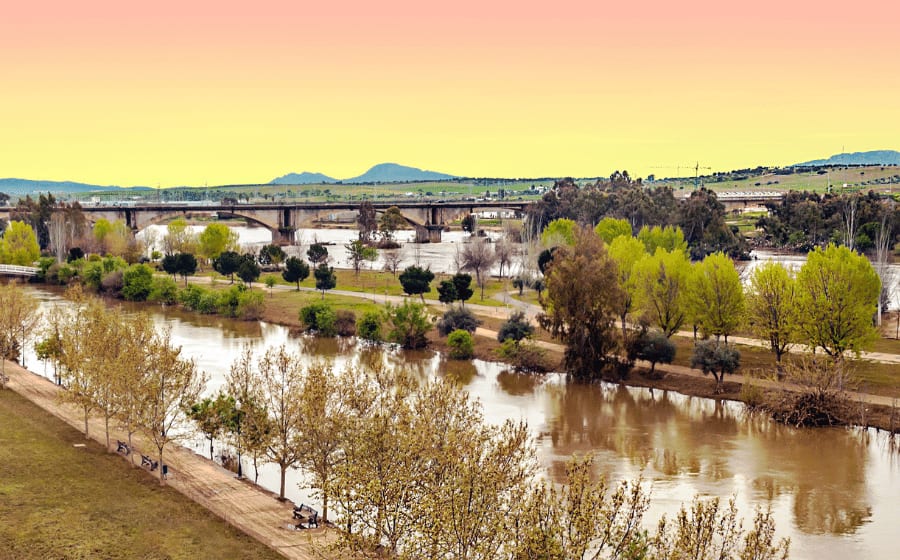The Tagus River: 2 Locations, Interesting Facts and The Best Spots
November 21, 2022
Win a FREE Trip to Spain!
Exciting Announcement! For the first time, we're thrilled to offer exclusive trips to the heart of Spain - an experience like no other. This isn't your typical tourist journey; it's a unique opportunity to immerse yourself in authentic Spanish culture, alongside real locals and our passionate team.
But there's more! Simply by requesting information about this amazing trip, you'll be entered into a special draw to win a Fully Paid Trip to Spain for Two. And that's not all - everyone who inquires will receive an exclusive bonus gift, valued at $500, available only now.
Ready to Discover the Real Spain?Click Here ↑ to Request Information & Enter the Draw!
Did you know that part of the Tagus River is in Spain and another in Portugal? This is because the river is born in Spain and flows into Portugal after its long journey through the Iberian Peninsula.
The Tagus is one of the most important rivers in Spain and one of our geographic jewels. Moreover, the Tagus basin is the third largest in the Peninsula, with an extension of 80,600 km², after the Duero and the Ebro basin.
I have just given you a free tip! Still, in this article, you will discover even more exciting and interesting facts and the best places through which the Tagus River flows that you cannot miss.
Are you ready to dive into this new adventure and discover everything about the Tagus? I won’t keep you any longer, so let’s get started!
Table of Contents ▼ ▶
Where is the Tagus River located?

The Tagus River is located between Spain and Portugal. It rises in the Montes Universales, in the Sierra de Albarracín (Teruel, Spain). After 1,007 km, it flows into the Atlantic Ocean in Lisbon (Portugal).
Its route crosses the Iberian Peninsula from east to west with a slight inclination towards the southwest. Its first 816 km crosses four Spanish autonomous communities (Aragon, Castile-La Mancha, Madrid, and Extremadura) and six provinces (Teruel, Guadalajara, Cuenca, Madrid, Toledo, and Cáceres).
The Tagus will then form the border between Spain and Portugal for 46 km and will enter Portugal. Here it will run for 145 km through four Portuguese regions: Beira Baixa, Alto Alentejo, Ribatejo, and Estremadura, where the districts of Castelo Branco, Portalegre, Santarém, and Lisbon are located.
8 Interesting Facts about the Tagus River

1. How long is the Tagus river?
The Tagus River is 1,007 kilometers long, of which 816 kilometers are in Spanish territory, 46 kilometers form the border between Spain and Portugal, and the remaining 145 kilometers are part of Portugal.
2. How deep is the Tagus river?
The upstream part of The Tagus River (between Vila Franca de Xira and the Alcochete – Sacavém) has an average of approximately 2 meters. The middle part is more profound, with an average of 7 meters. Still, the downstream portion is the deepest, reaching 46 meters, making it the Tagus River’s main navigation channel.
3. Can you sail the Tagus river?
The Portuguese Tagus is navigable along its whole length, with two dams (Belver and Fratel) and a weir at Abrantes. However, in Spain, only the areas of Castrejón, Azután, Valdecañas, Torrejón, Alcántara, and Cedillo are navigable.
4. Can you swim in the Tagus river?
According to the Water Law (article 50.1), bathing is allowed in any surface water, i.e., rivers, springs, lakes, etc.
That said, there are four reasons why autonomous communities could prohibit bathing in some areas:
- Health protection, as some areas may have poor water quality and high bacterial or contamination levels leading to a health risk.
- Non-compliance with the quality requirements of current regulations.
- Existence of danger or impracticability for the bathing water area or lack of maintenance.
- Need for environmental conservation.
Depending on the autonomous community, bathing will be prohibited or allowed in the areas authorized for it. If you are going to travel, I recommend you take a look at the restrictions of that place.
5. Can you fish in the Tagus river?
The Tagus river has more than 1,000 km of banks where you can enjoy fishing. You will find excellent specimens such as huge barbel in the quieter areas and less current, as in the Safont stretch. It is also a very common place for carp and black bass fishing. The area of the Cornisa del Tajo is easily accessible and a perfect fishing spot.
The fishes you can find in the Tagus river are: Catfish, common carp, common barbel, gypsy barbel, black bass, pike, pike-perch, brown trout, saboga, sea bass, mullet, blue catfish, tench, bluegill, bogue, bleak, carassius, sun perch.
6. What are the tributaries of the Tagus river?
The tributaries of the Tagus River are characterized by being very dissymmetrical. Those belonging to the right bank of the river provide a greater flow, and the affluents of the left bank are characterized by being short and having little water.
Affluents of the Tagus River
Tributaries of the Tagus river from the right bank:
- Jarama River: is the longest river in the Community of Madrid, with 190 kilometers long. It rises in the Sierra de Ayllón and flows into the Tagus at the height of Aranjuez.
- Alberche River: it rises in the Sierra de Gredos and flows through the provinces of Avila, Madrid, and Toledo, along 177 kilometers.
- Tiétar River: it rises in the Gredos mountain range and crosses the provinces of Avila, Toledo, and Cáceres. It has a length of 150 kilometers.
- Alagón River: it rises in Frades de la Sierra, in the province of Salamanca. It enters Extremadura and runs for more than 200 kilometers.
- Zézere River: it is the longest tributary of the Tagus, with 242 km, and is the second most important river in Portugal. It rises in the Serra da Estrela mountain range.
- Erjas River: it rises in the Sierra de Gata and flows into the Tagus. It forms part of the border of Spain with Portugal in the northwest of the province of Cáceres.
Tributaries of the Tagus river from the left side:
- Guadiela River: it rises in the Serranía de Cuenca. It is 115 kilometers long.
- Almonte River: located on the western slope of La Villuerca and crosses the province of Cáceres, along 97 kilometers.
- Salor River: it is 120 km long and runs through the province of Cáceres.
- Sorraia River: it rises in the Freguesía de Couço. It runs for 155 km, flowing into the Tagus at Ponta da Erva.
- Sever River: it rises in the São Mamede mountain range. It flows into the Tagus at the Cedillo reservoir, covering 63 km.
7. What’s the volume of water in the Tagus river?
The Tagus River has an average flow of 456 m3/S. The Tagus River is characterized by a pluvial-nival regime that ranges from 350 m3/S in February and March to 11m3/s in the summer months.
8. Where does the name Tagus come from?
According to the Portuguese historian André de Resende, the name of the Tagus River comes from the Roman designation of the river, “Tagus,” which could be a tribute to an Iberian king named Tago.
Discover Tagus River Best Spots

All along the Tagus river, you can enjoy a lot of spectacular places that are worth visiting.
The area of the Alto Tajo is one of my favorites. You can find many places and activities there, such as hiking trails, cities and villages full of history and monuments or walking to see some waterfalls and caves.
So I’m going to make you a list of the best places where our beloved Tajo river passes through and that you can’t miss!
Aranjuez
You have to make a mandatory visit to the Royal Palace, which was built by order of Felipe II in the XNUMX century. And I recommend you take a walk through the gardens surrounding the palace, they are spectacular! Ohh! and don’t forget to try some of the local products. Among the most famous are asparagus, strawberries, and dishes prepared with them, like the pickled partridge with strawberries.
Toledo
It is considered the most important city in Spain through which the Tagus River flows. If we talk about Portugal in that case, it would be Lisbon, its capital. Toledo was the capital of the Hispano-Visigothic kingdom and was declared a World Heritage Site in 1986. Remember to visit the impressive Cathedral of Santa Maria, Gothic style, and see inside, as it is very worthwhile. I recommend spending a weekend enjoying this spectacular city and its incredible gastronomy with some of the most famous Spanish dishes!
Talavera de la Reina
A charming city where you can visit several monuments, an Arab fortress, and the Nuestra Señora del Prado basilica. Talavera is famous for its pottery, which is considered one of the best in the world. Here you can also enjoy exquisite food!
Zafra Castle
Located about 6 kilometers from Campillo. One of the scenes of Game of Thrones was filmed here.
Barranco de la Hoz
A spectacular ravine surrounded by reddish walls hundreds of meters high, located in the province of Guadalajara.
Molina de Aragón
One of the most important historical-artistic sites of Castile-La Mancha, it is the most populated municipality of the Alto Tajo. Visit the castle, the historic center, and the Romanesque bridge.
Taravilla
There’s a viewpoint you will have incredible views of the Tajo Gorge. You may be lucky and see a bird of prey!
If you are a bird lover, I recommend you take a look at these two articles:
In Taravilla you must also go to see the Lagoon and the Poveda waterfall. A gorgeous waterfall and one of the most visited places in the Alto Tajo.
We have a whole post dedicated to the best waterfalls in Spain, which I highly recommend!
St. Peter’s Bridge
A lovely place to visit any time of the year, although if you go in summer, you can enjoy a small artificial beach and take a refreshing swim!
Los Casares Cave
In this cave are preserved some engravings and paintings of the Upper Paleolithic. It was found a metacarpus of Neanderthal Man and several animal fossils. Above the cave is the Atalaya de Riba de Saelices (a 9th-century Arab tower).
Don’t miss the most berautiful caves of Spain by clicking on the following link:
When you were at school, and you had to study the Tagus River, were you lazy? I was! It was so boring for me that I did not pay much attention. That’s why I organized the post differently to make it more enjoyable.
How did you find the post? Was it easy and entertainging to read?
I hope you enjoyed it and learned more about one of our most important rivers!
If there is any place that does not appear on the list that we can’t miss, we would love you to share it with us!











